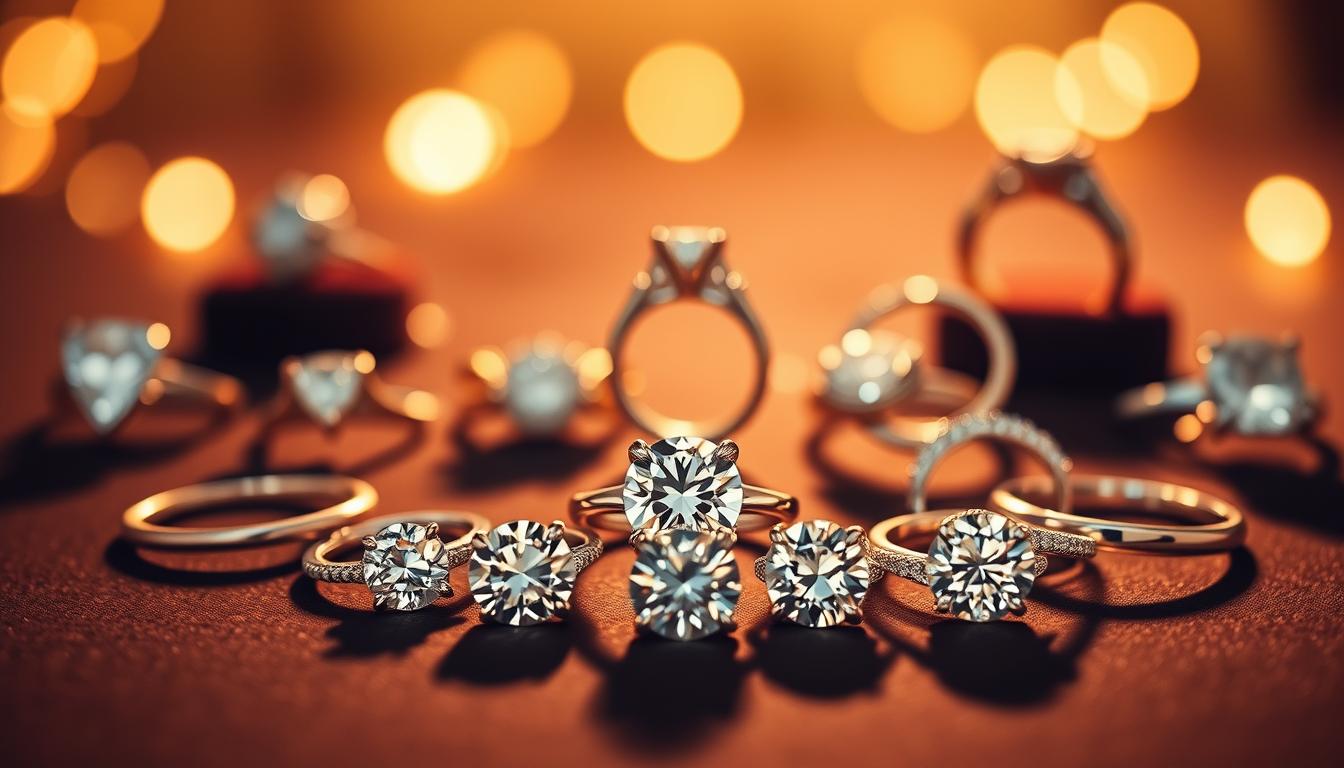When it comes to choosing the perfect symbol of love and commitment, many are now turning to lab-grown diamonds as a modern and ethical alternative to traditional mined diamonds.
Lab-made engagement rings offer the same beauty and durability as their natural counterparts, but with significant ethical and environmental advantages. Chemically identical to mined diamonds, these diamonds are not simulations or imitations, but real diamonds grown using advanced technology.
As conscious consumers and celebrities alike increasingly opt for lab-grown diamonds, this guide will help you understand the benefits of choosing a lab-made engagement ring, from ethical sourcing and reduced environmental impact to cost advantages and a wide variety of styles.
What Are Lab Made Engagement Rings?
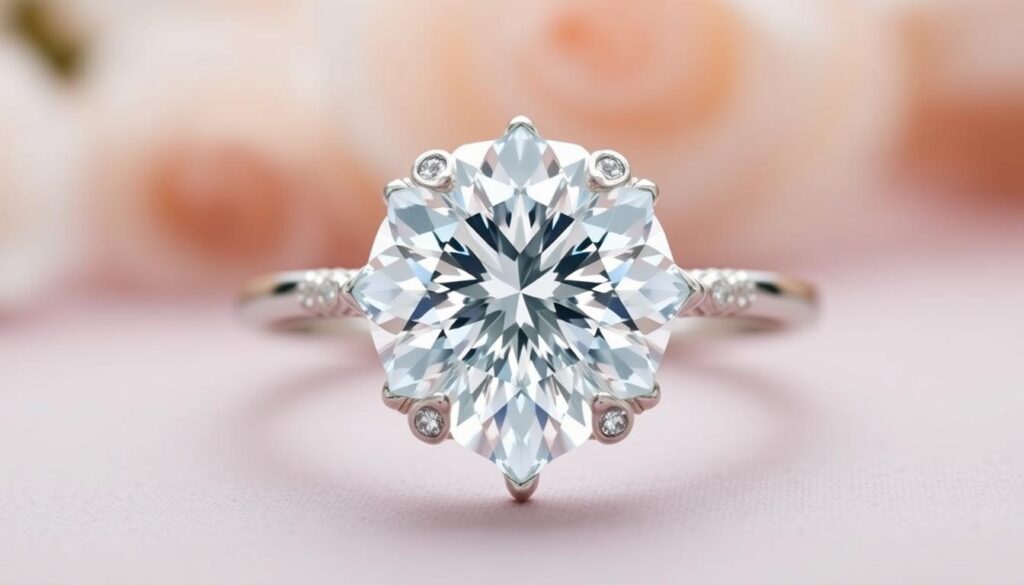
Lab grown diamonds are changing the way we think about engagement rings, offering a blend of luxury and conscience. Lab made engagement rings feature diamonds created in controlled laboratory environments rather than mined from the earth.
These diamonds are physically, chemically, and optically identical to natural diamonds, sharing the same carbon structure. They are created using either High Pressure High Temperature (HPHT) or Chemical Vapor Deposition (CVD) processes.
Not to be confused with diamond simulants, lab grown diamonds are certified and graded using the same standards as natural diamonds, ensuring they offer the same beauty, sparkle, and durability as traditional diamond rings.
The Science Behind Lab Grown Diamonds
The science behind lab grown diamonds is a fascinating blend of technology and gemology. These diamonds are created using two primary methods: High Pressure High Temperature (HPHT) and Chemical Vapor Deposition (CVD).
- HPHT mimics the natural conditions under which diamonds form in the earth, using extreme pressure and heat to transform carbon into lab grown diamond.
- CVD involves introducing carbon-rich gas into a chamber where it breaks down and deposits carbon atoms onto a lab grown diamond seed.
Both processes result in real diamonds with the same physical, chemical, and optical properties as mined diamonds. This scientific advancement has made it possible to create lab grown diamonds in weeks rather than the billions of years required in nature.
Benefits of Choosing Lab Made Engagement Rings
Choosing a lab-made engagement ring comes with a multitude of advantages, from ethical considerations to financial benefits. This option is not only beautiful but also responsible.
Ethereal and Environmental Advantages
Lab-grown diamonds eliminate concerns about conflict diamonds and unethical mining practices. They offer significant environmental benefits, including a reduced carbon footprint, less land disruption, and minimal water usage compared to traditional diamond mining. By choosing lab-made engagement rings, couples can align their values with their purchase decision.
Cost Benefits and Value
Lab-made diamonds typically cost 20-40% less than comparable natural diamonds, allowing consumers to get more value for their budget. The lower price point often means buyers can afford a larger carat size or higher quality lab grown diamond. This makes lab made engagement rings an attractive option for those seeking both beauty and value.
- Significant cost savings without compromising on quality or beauty
- Ethical and environmental benefits that align with personal values
- Access to a wider range of options in terms of carat size and quality
Lab Grown vs. Natural Diamonds: Understanding the Differences
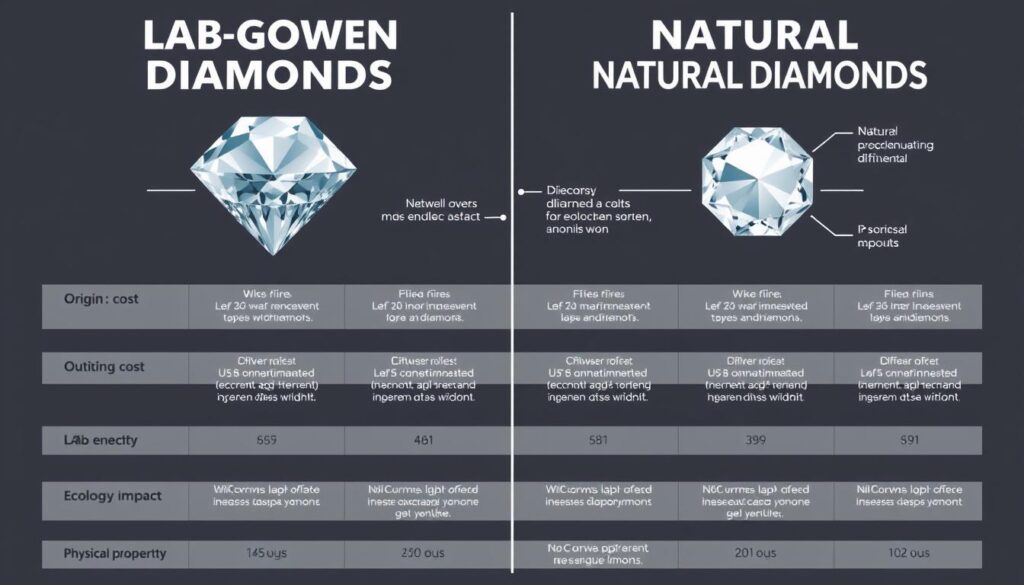
Lab grown diamonds and natural diamonds have distinct origins, but how do they compare in terms of quality, price, and environmental impact? Lab grown diamonds are created in controlled environments, while natural diamonds form underground over billions of years.
Despite their different origins, both types of diamonds are chemically, physically, and optically identical. They are composed of carbon atoms and are considered real diamonds. However, experts and gemological equipment can distinguish between them, even though the average person cannot tell them apart visually.
One significant difference lies in their price: lab grown diamonds typically cost 20-40% less than comparable natural diamonds. This price difference is a crucial factor for many buyers. Additionally, lab grown diamonds are often seen as a more ethical and environmentally friendly choice.
It’s also important to address common misconceptions about lab grown diamonds. They are not “fake” or of lower quality; they receive the same certification and grading as natural diamonds from respected gemological institutes. However, the resale value of lab grown diamonds may differ from that of natural diamonds, which is an important consideration for some buyers.
Popular Lab Made Engagement Ring Styles
The beauty of lab made engagement rings lies in their versatility, with numerous styles to choose from. Whether you’re looking for a classic design or something more modern, there’s a lab made engagement ring to suit your taste.
Classic Solitaire Settings
A timeless choice, classic solitaire settings feature a single center stone on a simple band, allowing the lab grown diamond to be the focal point.
Halo and Double Halo Designs
Halo and double halo designs surround the center stone with smaller diamonds, creating the illusion of a larger stone and adding extra sparkle.
Three-Stone and Side Stone Options
Three-stone settings symbolize a couple’s past, present, and future, while side stone options incorporate additional diamonds along the band, enhancing the ring’s overall brilliance.
With various styles like halo, solitaire, and three-stone settings, lab made engagement rings offer a stunning visual impact, making them an excellent choice for any couple.
Diamond Shapes for Lab Made Engagement Rings
The world of lab created diamonds is rich with different shapes, each with its unique charm. Whether you’re drawn to classic styles or more contemporary designs, the shape of your lab grown diamond can significantly impact the overall aesthetic of your engagement ring.
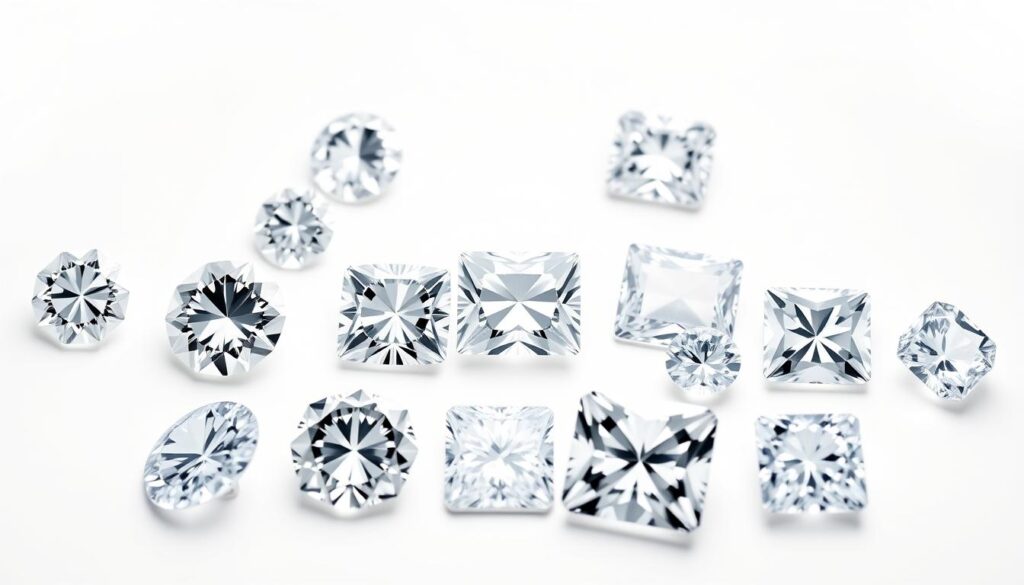
Round Brilliant Cut
The round brilliant cut is the most popular choice, known for its exceptional sparkle due to its 58 facets that maximize light reflection. This classic shape is timeless and suits most engagement ring settings.
Oval and Pear Shapes
Oval and pear shapes offer an elongating effect on the finger, making them a great choice for those looking for a slimming appearance. The pear shape combines the best of round and marquise cuts, providing excellent brilliance.
Emerald and Cushion Cuts
Emerald cuts feature step-cut facets that create a hall-of-mirrors effect, giving them a unique, sophisticated look. Cushion cuts, on the other hand, blend a square shape with rounded corners, offering a soft, romantic appearance.
Princess and Other Fancy Cuts
Princess cuts are modern square options known for their exceptional brilliance. Other fancy cuts like marquise, asscher, and radiant offer a range of styles to suit different preferences. The beauty of lab grown diamonds lies in their versatility, allowing them to be cut into any shape imaginable.
Ultimately, the choice of diamond shape is a personal one, reflecting the wearer’s style and preferences. With so many shapes to choose from, you’re sure to find the perfect lab made engagement ring that suits your taste.
- Round brilliant cut for maximum sparkle
- Oval and pear shapes for an elongating effect
- Emerald and cushion cuts for unique styles
- Princess and other fancy cuts for modern looks
Metal Options for Your Lab Made Engagement Ring
When it comes to choosing the perfect lab made engagement ring, the metal setting plays a crucial role in enhancing the diamond’s beauty. The right metal can complement the lab grown diamond, adding to its overall brilliance and style.
White Gold (14K and 18K)
White gold is a popular choice for lab made engagement rings, offering a contemporary and sleek appearance. Both 14K and 18K white gold enhance the diamond’s brilliance with their bright, silvery look.
Yellow Gold (14K and 18K)
Yellow gold provides a warm, traditional aesthetic that beautifully contrasts with the sparkle of lab grown diamonds. Available in 14K and 18K options, yellow gold adds a touch of classic elegance to the engagement ring.
Rose Gold (14K and 18K)
Rose gold is a romantic and vintage-inspired choice, characterized by its distinctive pinkish hue. Both 14K and 18K rose gold options are available, offering a unique and stylish alternative for lab made engagement rings.
Platinum and Two-Tone Options
For those seeking a premium option, platinum is a naturally white metal that’s hypoallergenic and extremely durable. Two-tone options, combining different metals like white and rose gold, offer a personalized and unique design. The choice between 14K and 18K metal affects both color intensity and durability, with 14K being more durable and 18K having a richer color.
Understanding Lab Grown Diamond Quality
Evaluating lab grown diamonds involves considering several key factors that determine their overall quality and value. Like natural diamonds, lab grown diamonds are assessed based on the 4Cs: carat, cut, color, and clarity.
The 4Cs: Carat, Cut, Color, and Clarity
The quality of a lab grown diamond is determined by its carat weight, cut quality, color grade, and clarity. Carat weight refers to the diamond’s size and is a key factor in pricing, with larger diamonds being more rare and expensive. The cut quality affects a diamond’s brilliance and sparkle, with excellent cuts commanding premium prices regardless of origin.
- Carat weight influences the diamond’s size and price.
- Cut quality impacts the diamond’s brilliance and value.
- Color grading ranges from D (colorless) to Z (light yellow).
- Clarity grades evaluate the presence of internal inclusions and external blemishes.
As Forbes notes, “The 4Cs are the universal language for diamond quality, allowing consumers to compare diamonds across different sellers.” Lab grown diamonds receive certification from the same respected gemological laboratories as natural diamonds, such as the Gemological Institute of America (GIA) or the International Gemological Institute (IGI).
Certification and Grading
Lab grown diamonds are certified and graded by reputable gemological laboratories, ensuring their quality and authenticity. Understanding the 4Cs helps consumers make informed decisions and compare options effectively, knowing that lab grown diamonds can achieve the same high-quality grades as natural diamonds across all evaluation criteria.
Popular Lab Made Engagement Ring Collections
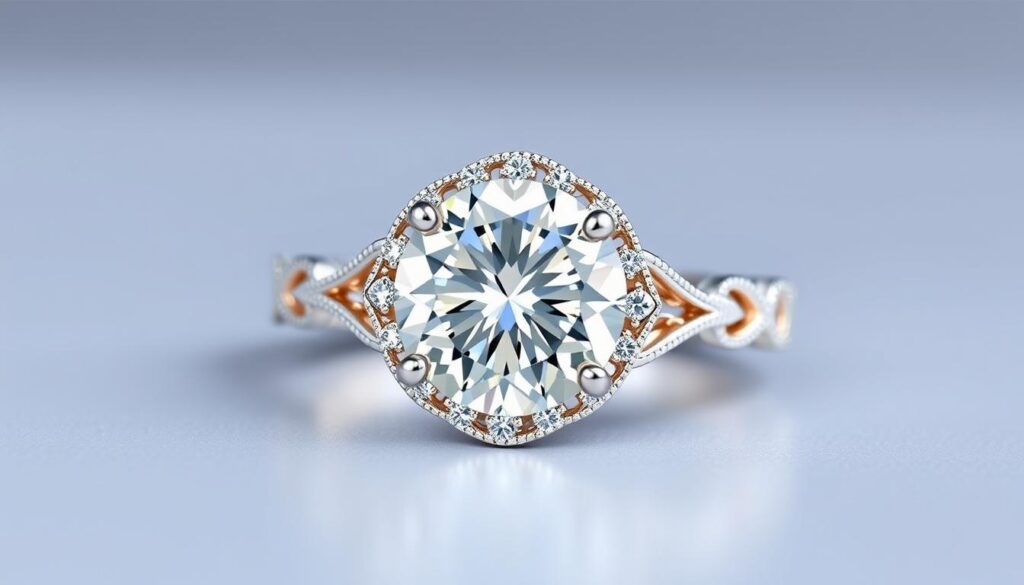
Leading jewelry designers are now showcasing exquisite lab made engagement ring collections that are both eco-friendly and luxurious. Collections like The Ashley Set with a 2-carat round lab diamond, priced at $2,050, and The Lexie Set at $2,100, offer a range of styles to suit different tastes.
Other popular collections include The Eleanor Set ($2,150), The Alison Set ($2,150), and The Katelyn Set ($2,200), each featuring a 2-carat round lab diamond. These collections often come with matching wedding bands, creating a coordinated bridal set.
Customizing Your Lab Made Engagement Ring

Creating a custom lab-made engagement ring is an exciting journey that allows couples to put their personal touch on their symbol of love. With lab-grown diamonds, you can select the perfect diamond shape, size, and quality to fit your style and budget.
The customization process involves choosing a setting style, metal type, and design details such as milgrain, filigree, or engraving. Some retailers even offer complete custom design services, allowing you to work with designers to craft a ring from scratch.
Customization ensures that the ring perfectly reflects the recipient’s personal style. While custom orders may take longer, technology like 3D rendering enables you to visualize your design before production. Importantly, customization doesn’t have to mean higher prices; you can control which elements to invest in, making it a cost-effective way to create a unique engagement ring.
Lab Made Engagement Rings for Every Budget
Whether you’re looking to splurge or save, lab made engagement rings provide a beautiful and ethical choice for any budget. These rings are available across various price points, making them accessible to shoppers with different financial plans.
Affordable Options Under $2,000
For those on a tighter budget, entry-level lab made engagement rings under $2,000 offer excellent value. These rings often feature smaller carat weights or simpler settings but still maintain high quality. Examples include The Ashley Set with a 2-carat round lab diamond at $2,050 and The Lexie Set at $2,100.
Mid-Range Choices ($2,000-$5,000)
The mid-range category offers more design options and larger center stones. For instance, The Eleanor Set and The Alison Set, both featuring a 2-carat round lab diamond, are available at $2,150. This price range allows for a balance between quality and affordability.
Luxury Lab Grown Rings (Over $5,000)
For those willing to invest in a premium engagement ring, luxury lab grown rings over $5,000 offer intricate designs and larger diamonds. Some examples have been discounted significantly, such as a ring reduced from $6,999 to $4,999, showcasing the potential for savings.
Lab grown diamonds typically offer a 20-40% price advantage over comparable natural diamonds, allowing buyers to get more for their money. Factors influencing the price include diamond size, quality, setting complexity, and metal choice. With lab made engagement rings, quality doesn’t have to be compromised at any price point, making them an attractive option for couples.
- Lab made engagement rings are available across various price points.
- Entry-level options under $2,000 offer excellent value.
- Mid-range selections ($2,000-$5,000) provide more design options.
- Luxury lab grown rings over $5,000 feature premium designs and larger diamonds.
By choosing lab made engagement rings, couples can enjoy significant savings, especially during promotions. For example, some rings have been reduced from $5,499 to $2,499, offering substantial value.
How to Care for Your Lab Made Diamond Ring
Caring for your lab grown diamond ring is crucial to maintaining its beauty and integrity. To keep your lab made diamond ring looking its best, regular cleaning is essential.
Here are some tips to care for your ring:
- Clean your ring regularly using mild soap, warm water, and a soft toothbrush to remove oils and debris that can dull the diamond’s sparkle.
- Remove your lab diamond ring during activities that could damage it, such as heavy lifting, sports, or working with harsh chemicals.
- Have your ring professionally cleaned and inspected every 6-12 months to ensure the setting remains secure and the diamond is properly positioned.
- Store your lab grown diamond ring in a fabric-lined jewelry box or pouch separate from other jewelry to prevent scratches.
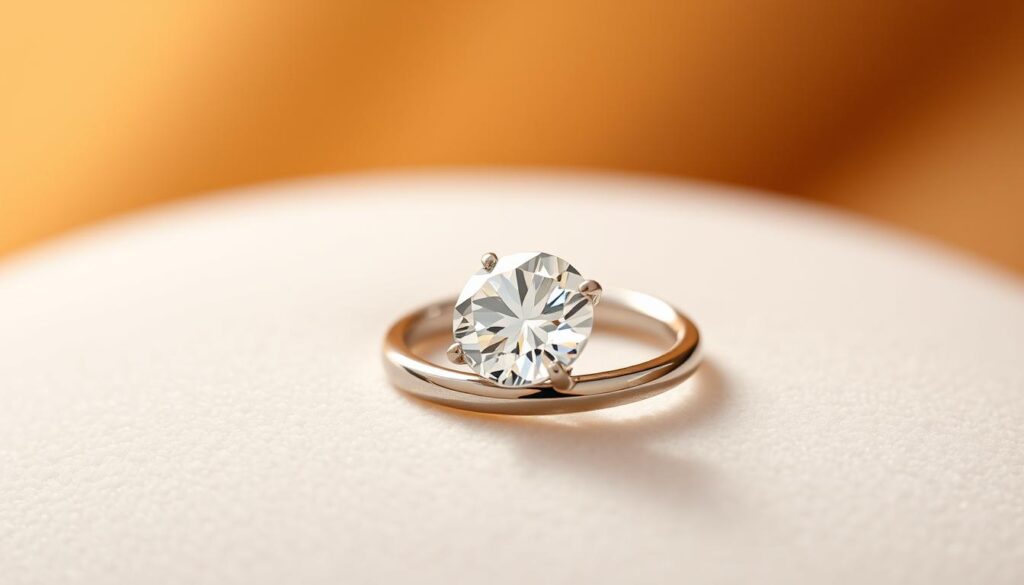
While lab grown diamonds are just as durable as natural diamonds, rating 10 on the Mohs hardness scale, settings can still be damaged. Proper care will help maintain the ring’s beauty and value for generations.
Shopping for Lab Made Engagement Rings Online

Finding the ideal lab made engagement ring online requires careful consideration and research. When shopping online, it’s crucial to choose reputable retailers that specialize in lab grown diamonds and provide detailed product information.
What to Look for in a Retailer
Look for retailers that offer certification from respected gemological laboratories for all their lab grown diamonds. High-quality images, videos, and 360-degree views are also essential, allowing customers to examine rings thoroughly before purchase.
Understanding Warranties and Return Policies
Many quality retailers offer lifetime warranties on their lab grown diamonds. Reputable sellers typically offer at least 30 days for returns if the customer isn’t satisfied. Additionally, consider retailers that provide free shipping and secure, insured delivery methods.
Customer Experiences with Lab Made Engagement Rings
Many customers have shared their positive experiences with lab made engagement rings, praising their quality and ethical sourcing. Couples who have chosen lab grown diamonds for their engagement ring often report high satisfaction with their decision.
Customers appreciate the value proposition of lab grown diamond rings, noting that they were able to get larger or higher-quality diamonds within their budget. The reaction to receiving a lab made engagement ring is often one of surprise and delight, with many recipients being unable to tell that the ring is not mined.
Long-term satisfaction reports from customers who have owned their lab made rings for several years indicate that these rings remain a cherished possession. Diverse perspectives from various demographics show the broad appeal of lab made engagement rings, with many customers becoming advocates for lab grown diamonds after their positive experiences.
Frequently Asked Questions About Lab Made Engagement Rings
If you’re considering a lab made engagement ring, you’re probably wondering about the differences between lab grown and natural diamonds.
One of the most common questions is whether lab grown diamonds are “real” diamonds. The answer is yes; they are chemically, physically, and optically identical to mined diamonds.
Another concern is how to distinguish between lab grown and natural diamonds. Only specialized equipment or trained professionals can tell them apart.
Lab grown diamonds come with certification from respected gemological laboratories, just like natural diamonds. They are also just as durable and long-lasting.
When it comes to insurance and resale value, lab grown diamonds are treated similarly to natural diamonds, although resale value can vary.
Disclosure and transparency are important when giving a lab grown diamond as an engagement ring. Reputable sellers provide clear information about the diamond’s origin.
Making the Perfect Choice: Finding Your Ideal Lab Made Engagement Ring
Selecting the perfect lab made engagement ring can be a daunting task, but with the right guidance, it can be a truly enjoyable experience.
To start, consider your budget to narrow down options and set realistic expectations. Research the recipient’s style preferences by observing their current jewelry or getting input from friends and family.
When it comes to the lab grown diamond, balancing the 4Cs (carat, cut, color, and clarity) is crucial to maximize value based on what’s most important to the individual. For instance, if size matters, you may prioritize carat weight, but if sparkle is key, cut quality becomes paramount.
It’s also essential to consider lifestyle factors when selecting a ring setting style, as some designs are more practical for active individuals. Visiting showrooms to see lab grown diamonds in person can make a significant difference in making a final decision.
Utilizing online tools like virtual try-on features or home try-on programs offered by some retailers can further enhance your shopping experience. Ultimately, the perfect engagement ring is one that aligns with both personal values and aesthetic preferences.
Remember, the meaning behind the ring matters more than its specific characteristics, making the choice even more personal and significant.
Conclusion
The journey through the realm of lab grown diamonds reveals a world where technological innovation meets conscious consumerism. Lab made engagement rings offer the same beauty and durability as natural diamonds, with added ethical and environmental benefits. Couples can choose from a variety of styles and settings, allowing for a personalized symbol of their love.
With lab made engagement rings, many couples can afford a larger diamond or more intricate setting, enhancing the overall value of their purchase. As you consider your options, reflect on your personal values and priorities. Armed with this knowledge, you can make an informed decision that not only symbolizes your love but also reflects your responsibility toward the planet.
